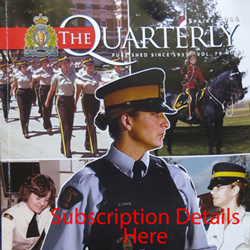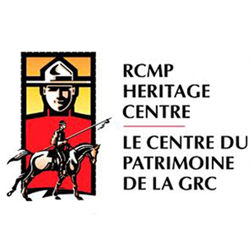Did You Know- Stain Glass Windows?

Veteran Ric Hall sent us this article and provides an insight to how the image has the Force has been incorporated in the Canadian stamp.
The first Mountie Stamp – 1935
The Royal Canadian Post Office releases June 01, 1935, a new 10-cent postage stamp depicting a Mounted Policeman on a horse. This is the first ever postage stamp to include a Mountie on it, several more will be produced over the next 82 years, including one in 1999 that is a reproduction of the original.

Other stamps with a Force theme.

The Mounties on the Canadian $50.00 bill

Sergeant Donald Frederick Guerrette, Reg # 18226, served from 1953 to 1991 in ‘HQ’ ‘F’ ‘A’ ‘HQ’ ‘H’ ‘D’ & ‘HQ’ retiring from the Video Production Sec. The Musical Ride was featured on the Canadian fifty-dollar bill of the Scenes of Canada banknote series produced on March 31, 1975. The back of the new $50.00 bill “Musical Ride” was taken from a photo by Guerrette and the Force was presented with bill bearing serial # 100 by the Governor of the Bank of Canada to commemorate services of the Force against counterfeiting. That bill, framed, hung in the Commissioner’s office. I wonder where it is now? Sergeant Guerrette passed away September 14, 2010 at Bancroft, ON.
When these bills were issued most young members could only dream of having a wallet full of them and no debit cards!
The RCMP Reserves
The policy to establish the RCMP Reserve was instituted by Commissioner MacBrien in 1937. The first body of the Reserve consisted of a group of about 400 selected men who had applied to enlist at a time when the strength of the Force was well established and the waiting list for recruitment was a very long time. Training for two months, in July and August, was offered, at the conclusion of which about 120 men were chosen to join the regular Force and the remainder returned home on a Reserve status. After their training period, the men who were not recruited from the initial group did not serve any police function. A number were recalled to engage as regular members over the next few years, and many joined the armed forces in 1939. The Reserve was uniformed as recruits for training at Fredericton, Rockcliffe, Regina and Vancouver, and were issued the brown serge uniform identified only by a special metal shoulder badge bearing the letter “R” above the letters “RCMP.” At no time were the members of the Reserve authorized to wear the Stetson, breeches, blue trousers or long boots.
The Reserves were used in “E” Division until they were disbanded in 1966. – CHECK OUT MORE DETAILS ON RESERVES HERE

Reserve Constable Jim Warren receives his discharge papers. The RCMP shoulder badge with the “R” above RCMP is visible on his brown serge tunic.
Sergeant Preston and Yukon King
Sergeant Preston and his staunch ally Yukon King, his lead sled dog… “On, King! On you huskies!”… is introduced to the world on a Detroit radio station in February 1938. Originally called Challenge of the Yukon began as a 15-minute serial, airing locally from 1938 until May 28, 1947. Shortly thereafter, the program acquired a sponsor, Quaker Oats, and the series, in a half-hour format, moved to the networks. The program aired on ABC from June 12, 1947 to December 30, 1949. It was then heard on The Mutual Broadcasting System from January 2, 1950 through the final broadcast on June 9, 1955. The title changed from Challenge of the Yukon to Sergeant Preston of the Yukon in November 1951, and remained under that name through the end of the series and into television. Lasting till 1955. From 1951 to 1958 there were 29 issues of Sgt. Preston comic books. A TV series of the same name aired from 1955 to 1958. In addition to creating Sgt. Preston, the writing team of George W. Trendle and Fran Striker also created The Lone Ranger and The Green Hornet dramas.
 The Dell comic book covers were paintings portraying drama or action, featuring Yukon King and Sergeant Preston in exciting scenes. Once the Sergeant Preston of the Yukon television series premiered the comic book featured photo covers of the TV series star in character as Sergeant Preston.
The Dell comic book covers were paintings portraying drama or action, featuring Yukon King and Sergeant Preston in exciting scenes. Once the Sergeant Preston of the Yukon television series premiered the comic book featured photo covers of the TV series star in character as Sergeant Preston.
Mounties on the Hill!
From the RCMP Quarterly; A new departure from the usual work on “N” Division commenced on July 17, 1939, when two members were detailed for mounted duty on Parliament Hill. These men will be on duty there all summer and are a great attraction for the tourists, cameras being much in evidence. How many Kodak moments did this order create! I wonder how long these duties lasted once World War II was declared?


Picture below I have inserted, just because, I think it is a great photo. Queen Elizabeth II is being escorted to address the opening of the Parliament in 1957. RCMP members in the shadows of the arches of Parliament.

Who was the member who posed for the stain glass windows
in the “Depot” Chapel?

John Roy Fraser, Reg # 13143, joined the Force, December 1938, in Westville, NS. He served until 1960 and retired as a Staff Sergeant. His service was in “O” Division. He did take his discharge, December 1943, for a short period of time to serve in the RCNVR during WWII but re-engaged, April 1946, soon after the wars end. He is forever entrenched in the history of the Force. He served as the model for the stain glass windows in the Chapel at “Depot” Division which were unveiled in June of 1944. The cost of the stain glass windows was $600.00. Family traditions in the Force have carried on. Both his son, John Fraser, Reg # 29287, and his grandson John Fraser, Reg # 55501, were and are members of the Force.

Photograph of John Roy Fraser – Reg.#13143
Two Commissioners with something, very sadly, in common.

Much has been written about these two Commissioners and what they did for the for the Force.
James MacBrien, Reg # 3588/O.240, joined the NWMP in April 1900, left to go to South Africa. Returned to Canada and served in World War I with the 1st Canadian Division and was wounded at Ypres. In 1916 he was promoted to Bridadier General in command of the 12th Canadian Military Brigade. Upon his return to Canada he was instrumental in forming the Department of National Defense and was appointed the Chief of Defense Staff. He retired in 1927 and in 1931 he was asked by the Prime Minister to be the 8th Commissioner of the RCMP. He is credited with bringing about a modernization of the Force. He continued to wear the uniform of a General Officer. He died while serving at the age of 59 years.
Stuart Zachary Taylor Wood, O.171 (JWC), was appointed the 9th Commissioner after the death of Commissioner MacBrien. He served as Commissioner for 13 years. He joined the RNWMP in Novemember 1912. He attended the Royal Military College in Kingston. Upon completing his formal education in 1912, Wood secured a commission in the Royal North West Mounted Police.
His father, Zachary Taylor Wood, served with the NWMP during some of the most colourful periods in the history of western Canada:
On August 01, 1885, Wood was appointed an inspector in the North-West Mounted Police, which was expanding because of the perceived danger of violence on the western frontier in the wake of the rebellion. In 1887 and 1888 he served under Superintendent Samuel Benfield Steele on an expedition into the Rocky Mountains of British Columbia, to counter the threatened uprising of the Kutenai under Chief Isadore. The intervention of the mounted police helped pacify the situation and laid the groundwork for resolution of a dispute over land ownership. Late in 1888 Wood was given the command of a division of NWMP and in the next nine years he exercised a number of independent commands in the North-West Territories.
The discovery of gold in the Klondike precipitated a rush of prospectors to the Yukon in 1897 and 1898. It also ensured the continued existence, and even growth, of the mounted police as it was required to enforce law and order in this new northern frontier. Inspector Wood was transferred there in 1897, and with Steele was in the forefront of establishing order in the potentially chaotic situation, first at the entry point at Skagway, Alaska, and then at Bennett Lake (Y.T./B.C.). Shortly thereafter, Wood was joined in the Yukon by his wife and family, who spent the next 13 years with him on this northern frontier. Promoted superintendent in 1898, Wood assumed command of the NWMP in the Yukon on 18 April 1900. He was raised to the rank of assistant commissioner in 1902, and remained in the territory until 1910. During the tenure of his command, he established a fine reputation for keeping the level of crime at a minimum and for the solution of the serious crimes that did occur. Under his direction the mounted police also performed a variety of services for the government and the community in the Yukon, from the collection of licence fees to the provision of relief supplies to those in distress.
Wood was transferred in 1910 to Regina, where he became second in command of the entire Royal North-West Mounted Police. From the time he came out of the north he suffered from ill health, including an incapacitating rheumatism, which the force and his family ascribed to the hardships of his service. For his outstanding contributions to law enforcement, he was appointed a Companion of the Order of St. Michael and St. George in 1913. Two years later he died while on sick leave in North Carolina.

Throughout his distinguished 38-year career with the RCMP S.T. Wood worked to preserve and commemorate its history and traditions. Not only did he see to the establishment of the first RCMP Museum in 1933-1934, he supported the penning of the official history of the North West Mounted Police by historian John Peter Turner — two volumes now viewed as the definitive chronicle of NWMP history.
However, it could be argued that Commissioner Wood’s most significant contribution to the preservation of RCMP heritage was his commitment to the perpetuation of its cavalry tradition and to the reconstruction of old Fort Walsh as the first breeding ranch for the Force’s signature black horses.
In 1937, Stuart Taylor Wood (as Assistant Commissioner) traveled to Britain with the RCMP contingent to the coronation of King George VI and Queen Elizabeth (the late Queen Mother). At the Coronation, he was so impressed by the sight of the scarlet-clad Lifeguards of The Household Cavalry riding uniform black horses that he resolved then and there that the RCMP should also be as distinctively mounted.
The following year he became Commissioner of the Force. In 1939, he ordered that all horses acquired by the Force be black. As there were too few uniform black horses available for sale, it was decided they would raise their own.
Wood first visited the site of old Fort Walsh in 1930; greatly taken by the Cypress Hills, he felt compelled to learn more about the history of the fort. He visited with local old-timers who had either lived in the area or served at the fort. His fascination with old Fort Walsh culminated with the purchase of the site from Frank Nuttall in 1942. Construction of the RCMP Remount Ranch began there the following year.
Commissioner Wood wanted RCMP Remount Ranch, as closely as possible, to be a reconstruction of the original NWMP fort. Sgt. David Fleming, who oversaw the reconstruction and identified the fort’s original foundations, drew up plans based on his discoveries and interviews with old-timers. Commissioner Wood’s daughter even recalls her father and Sgt. Fleming examining period photographs — trying to count the number of logs used in the original fort.
As well as fort construction, the spring of 1943 also saw the arrival of the first of the RCMP breeding stock: 23 mares, 11 foals and one stallion. The Fort Walsh ranch developed a successful breeding program, which produced large uniform black horses. The Fort Walsh Remount Ranch provided black horses for the mandatory recruit equestrian training at the RCMP training centre at “Depot” in Regina. When performances of the RCMP Musical Ride resumed in 1948 after the Second World War, the Ride featured all black horses.
At the 1953 coronation of Queen Elizabeth II, the RCMP proudly featured all black horses, thus realizing Stuart Taylor Wood’s dream.
Commissioner Wood retired from the Force in 1951. However, he retained “Special Constable” status, continuing to oversee the operations of the Fort Walsh ranch. He and his family would spend their summers at Fort Walsh living in the reconstructed “Commissioner’s Residence.”
After Commissioner Wood’s death in 1966, Fort Walsh (now a National Historic Site) was transferred to Parks Canada. As well, mandatory equestrian training for all officers was discontinued.
One thing that that these two Commissioner’s had in common was that each had a son attend the Royal Military College at the same time prior to World War II.
The July 1939 RCMP Quarterly had the following written under “press clippings”: Members of the RCMP in Ottawa are proud of the showing made at the Royal Military College of Canada by two sons of the Force. Battalion Sergeant Major Michael D. MacBrien has won the sword of honour for conduct and discipline. He is the youngest son of the late Major-General Sir James MacBrien, who at the time of his death was Commissioner of the RCMP. Sergeant Donald Zachary Taylor Wood, son of Commissioner S.T. Wood of the RCMP, awarded the gold medal for the highest aggregate marks through the entire course at RMC. He has won all three of the Governor General’s medals, the bronze, silver and gold, as well as other prizes.

Above left: RMC graduate Michael MacBrien and right his father James MacBrien

Left: RMC graduate Donald Wood and right his father S.T. Wood as a RMC graduate
Thanks to Inspector Dave Hall (RMC graduate 1996) for the photos from the RMC 1939 yearbook. The family resemblances are very clear.
They both graduated in June of 1939, with World War II looming on the horizon. Michael MacBrien served in the RCAF and died in a plane crash January 01, 1941 during a training exercise in Manitoba. Donald Wood also served in the RCAF and died in a plane crash in the European Theater of Operations. He died October 14, 1944 when the plane he was piloting on a mission from England to Germany crashed after its engine caught fire.
Commissioner S.T. Wood lost another son, Constable Herschel Taylor Wood, Reg # 14757, who was a member of the Force. While stationed in “K” Division at Cardston Detachment, he and another member were pursuing an investigation in Montana. Upon their return Constable Wood was driving and apparently lost control while Glacier Park, Montana, going over an embankment into a creek and hit a concrete abutment. Both members were severely injured. They were transported by to Calgary where Constable Wood passed away.

Constable Herschel Taylor Wood – # 107 on the RCMP Honour Roll
John Taylor Wood, Reg # 16821/O.628, was another son of S.T. Wood, joined in 1951 and was Struck Off Strength in 1988. He retired as a Superintendent.
Unable to locate a photo.



 November 22, 2017
November 22, 2017 






